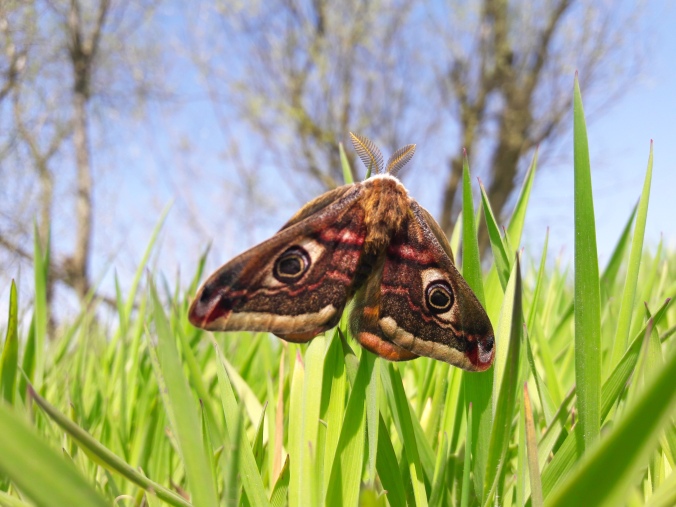I have often been asked, and indeed have often asked, what the difference is between a moth and a butterfly. As a child my answer would have been easy – a butterfly flies during the day and a moth at night, but in fact it isn’t so easy. The truth is there are many day flying moths and indeed a few butterflies which flit about around dusk and dawn. The line between these two groups of insects becomes more blurred with new species still discovered. Yet here are a few good tips;
– Moths have big fuzzy antennae whilst butterflies have straight and smooth antennae
– Moths generally fold their wings up like tents whereas butterflies fold them straight up behind their backs
– Moth cacoons are woven with silk whilst a butterflies cacoon is smooth and hard, without silk
– Moths are generally quite soft and furry whilst butterflies are much smoother

An exception to the rule, skipper butterflies do not fold their wings up behind their body and are rather fluffy l.
Importantly its also worth knowing that over 80% of Lepidoptera (the group that butterflies and moths sit in) across the world are moths, with butterflies making up the remains. So whilst butterflies may be more likely to grab our attention the truth is that moths rule the roost.

One common misconception, and one I read often when looking into moths and butterflies, is that all moths are drab and dull whilst all butterflies are draped in beauty. In fact across the world we have some truly stunning moths such as the atlas moth or the owl moth. Even in the UK we have some true beauties from the swallowtail moth to the cinnabar moth. Some of these beauties look like they’d be more at home in the tropics such as the fascinating hawk-moths, but nothing can be more surprising to find hiding in plain site than the emperor moth.

The emperor moth is the UK’s largest moth species, and the only member of the notorious silkworm family, the domesticated cousins of which clothed the emperors of bygone eras. The female reaches a wingspan of 9cm, whilst the diminutive male is still a whopper at 6cm. Both possess glorious patterning of large peacock feather type eyelet markings and wonderfully orange under wings. Both are used to scare off and intimidate predators, with the moth revealing its pair of hind wings and vibrating when threatened in the hope of being mistake for a large many eyed beast. The male also has an added bronze colouring across the rest of its wings, whilst the larger female is a more subdued grey.
Across the country emperor moths are thought to be widespread and fairly common in their chosen habitat, which ranges from heathlands and bogs to sand dunes. Their diet is widespread, with caterpillars largely munching woody species such as heather, sallow and blackthorn, whilst some softer stemmed plants such as meadowsweet are also eaten. The adults are unable to eat, spending their short lives in search of a mate instead.

If and when you first get a chance to see an emperor moth you will probably find yourself wondering how something so large and colourful could possibly have escaped your attention till now. Well the truth is the emperor moth isn’t an easy one to spot. This is due to the fact that the larger female is only active at night, resting in thick vegetation during the day, attracting males closer with her pheromones. The smaller male does fly during the day, searching out the females, however small, orange and quick flying he’s easily confused with a passing butterfly, such as a small tortoiseshell. Even moth traps are unlikely to help with the females only occasionally being attracted to the light and males taking no interest at all.
The lifecycle of the emperor moth similarly helps to keep it largely hidden. Its flight period as an adult is short and early, running from April – May. Eggs are laid during this period with the small dark caterpillars growing slowly throughout the summer. By August they are at their most distinguishable, almost 6cm long, bright green, with black dots arranged in rings, their centres occasionally coloured orange or pink. It’s around this time they weave their silken web around themselves, cacooning ready for the winter, only to emerge the following April.
My own encounter with a male emperor moth was down to chance and the ever giving community of wildlife enthusiasts which I often learn so much from. Having attempted several times to hunt out this fascinating species by wandering through rugged heathland at the appropriate time of year I happened to be out on a walk of a different kind when we bumped into a gentlemen of acquaintance who spends most of his free time looking for and photographing wildlife, who just happened to have an emperor moth lure in his pocket. Manufactured to replicate the chemical smells of the female this lure quickly called in five males on a day that was previously entirely bereft of emperor moths. We watched them in wonder before repackaging the lure and once more allowing them on their way. It just goes to show, wildlife is often hidden, rarely easy to spot but always fascinating.